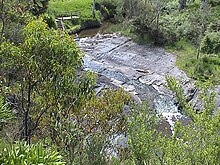烏拉爾世
外觀
| 烏拉爾世 | |
|---|---|
 烏拉爾世時期的世界地圖 | |
| 地質年代 | |
二疊紀主要分界 -300 — – -295 — – -290 — – -285 — – -280 — – -275 — – -270 — – -265 — – -260 — – -255 — – -250 — 二疊紀時間表 直軸:百萬年前 | |
| 詞源 | |
| 名稱是否正式 | 正式 |
| 同義名 | 早二疊世 |
| 具體信息 | |
| 天體 | 地球 |
| 適用區域 | 全球(ICS) |
| 適用時標 | ICS |
| 定義 | |
| 地質年代單位 | 世 |
| 年代地層單位 | 統 |
| 名稱是否正式 | 正式 |
| 下邊界定義 | 牙形石綱鏈頜魚屬分化 |
| 下邊界GSSP位置 | 哈薩克斯坦境內的烏拉爾山脈 50°14′45″N 57°53′29″E / 50.2458°N 57.8914°E |
| GSSP批准時間 | 1996[1] |
| 上邊界定義 | 牙形石綱真貢多拉屬出現 |
| 上邊界GSSP位置 | 美國德克薩斯州瓜達洛普山脈 31°52′36″N 104°52′36″W / 31.8767°N 104.8768°W |
| GSSP批准時間 | 2001[2] |
烏拉爾世(英語:Cisuralian)又稱早二疊世,是2.99億至2.72億年前的一個地質時代。烏拉爾世是二疊紀的第一個地質世,前後分別是賓夕法尼亞世和瓜達洛普世。烏拉爾世以烏拉爾山脈命名[3][4][5]。該時期出現了蒼蠅和甲蟲。
名稱由來
[編輯]1982年,取材於俄羅斯—哈薩克斯坦的烏拉爾山脈[6][7][8],「Cisuralian」(烏拉爾世)被提名[9],1996年獲得國際上的正式批准[10]。烏拉爾世的準確地質跨度為298.9±0.15—272.3±0.5百萬年前[11]。二疊紀的開始標誌是出現孤立鏈頜魚。其地層的全球界線層型剖面和點位(GSSP)位於哈薩克斯坦烏拉爾山區的阿克托別地區[12]。
地理
[編輯]岡瓦納大陸與勞亞大陸合併,在北美洲進行阿萊干尼造山運動[6]。歐美大陸與岡瓦納大陸碰撞,在西北歐則進行華力西造山運動[6]。盤古大陸逐漸形成,並對氣候產生影響[6]。
氣候
[編輯]
石炭紀時期的冰河時代一直延續到二疊紀初期。二疊紀中期時,氣候轉暖,冰川消退,內陸地區逐漸乾旱[13]。
生物
[編輯]烏拉爾世時期,出現了甲蟲蒼蠅。沼澤地帶蕨類植物,種子蕨和石松門植物較多[6]。
石炭紀時期的煤炭沼澤、闊齒龍和基龍依然存在[7]。小型食蟲動物已經存在,居住在乾燥的洞穴中。此時出現了卡色龍和四角獸等動物[7]隨着氣候變暖,海洋生物種類繁多,可能比現代多出幾倍[6]。旋齒鯊也存在於此時期。
陸地生物以盆龍類、雙龍類和兩棲動物。盆龍類出現在賓夕法尼亞世,在烏拉爾世時種群數量達到頂峰,在之後的4000萬年中仍然繁榮,一直延續到卡匹敦期[14][15][7]。
-
旋齒鯊,下頜前部有「牙輪」(tooth-whorl)
下分期
[編輯]- 阿瑟爾期,298.9±0.15至294.6±0.8百萬年前。
- 薩克馬爾期,294.6±0.8至290.1±0.7百萬年前。
- 亞丁斯剋期,290.1±0.7至283.5±0.7百萬年前。
- 空谷期,283.5±0.7至272.3±0.5百萬年前。
參考
[編輯]- ^ Davydov, Vladimir; Glenister, Brian; Spinosa, Claude; Ritter, Scott; Chernykh, V.; Wardlaw, B.; Snyder, W. Proposal of Aidaralash as Global Stratotype Section and Point (GSSP) for base of the Permian System (PDF). Episodes. March 1998, 21: 11–18 [2020-12-07]. doi:10.18814/epiiugs/1998/v21i1/003. (原始內容存檔 (PDF)於2021-07-04).
- ^ GSSP for Roadian Stage. International Commission on Stratigraphy. International Commission on Stratigraphy. [2020-12-13]. (原始內容存檔於2021-10-25).
- ^ Gradstein, Felix M.; Ogg, James G.; Smith, Alan G. A Geologic Time Scale 2004. 2004. ISBN 9780521786737.
- ^ Ross, C. A.; Ross, June R. P. Permian Sequence Stratigraphy. The Permian of Northern Pangea. 1995: 98–123. doi:10.1007/978-3-642-78593-1_7.
- ^ Permian: Stratigraphy. UC Museum of Paleontology. University of California Berkeley. [2021-06-17]. (原始內容存檔於2022-02-05).
- ^ 6.0 6.1 6.2 6.3 6.4 6.5 Ross, June R.P.; Ross, Charles A. Permian Period. Encyclopædia Britannica. 2018-10-16 [2019-04-18]. (原始內容存檔於2022-02-26).
- ^ 7.0 7.1 7.2 7.3 Kazlev, M. Alan. The Cisuralian Epoch. palaeos.com. 2002-05-04 [2019-04-18]. (原始內容存檔於2021-06-09).
- ^ Allaby, Michael. A Dictionary of Geology and Earth Sciences 4th. Oxford University Press. 2015. ISBN 9780199653065. doi:10.1093/acref/9780199653065.001.0001.
- ^ Gradstein, Felix M.; Ogg, James G.; Smith, Alan G. A geologic time scale 2004. Cambridge University Press. 2004: 250 [2022-02-10]. ISBN 978-0-521-78673-7. (原始內容存檔於2021-11-16).
- ^ Ganelin, V.G.; Goman'kov, A.V.; Grunt, T.A.; Durante, M.V. On the revised stratigraphic scale for the Permian System adopted at the Second Guadalupian Symposium, alpine, Texas, USA, April 1996. Stratigraphy and Geological Correlation. January 1997, 5 (2): 126–130.
- ^ International Commission on Stratigraphy. GSSPs. [2018-07-10]. (原始內容存檔於2017-06-10).
- ^ Davydov, V.I.; Glenister, B.F.; Spinosa, C.; Ritter, S.M.; Chernykh, V.V.; Wardlaw, B.R. and Snyder, W.S.; 1998: Proposal of Aidaralash as Global Stratotype Section and Point (GSSP) for base of the Permian System, Episodes 21(1): pp 11–18.
- ^ Palaeos: Life Through Deep Time > The Permian Period 互聯網檔案館的存檔,存檔日期2013-06-29. Accessed 1 April 2013.
- ^ Huttenlocker, A. K., and E. Rega. 2012. The Paleobiology and Bone Microstructure of Pelycosaurian-grade Synapsids. Pp. 90–119 in A. Chinsamy (ed.) Forerunners of Mammals: Radiation, Histology, Biology. Indiana University Press.
- ^ NAPC Abstracts, Sto – Tw. berkeley.edu. [2022-02-10]. (原始內容存檔於2020-02-26).


